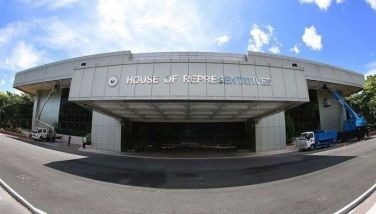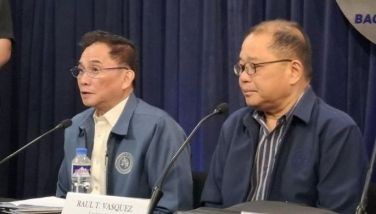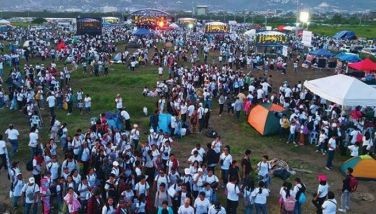Polio, TB threaten kids anew
March 13, 2002 | 12:00am
More than 250,000 Filipino children are at risk from serious diseases like polio and tuberculosis after a state immunization program faltered last year, a government survey shows.
Full immunization coverage for some two million infants aged 12-23 months dropped to 61.3 percent last year compared to 65.2 percent in 2000, Carmelita Ericta, administrator of the National Statistics Office (NSO), said.
Coverage in rural areas fell by six percentage points to 56.5 percent, while in urban areas full immunization rates dropped by 1.1 percentage points to 68 percent.
A child is considered fully immunized if he or she has received shots against tuberculosis, three doses of a vaccine for diphtheria, polio and tetanus, three doses of oral polio vaccine, and anti-measles vaccines before turning one year old, the NSO said on its website yesterday.
Three polio cases were found in Laguna, Cavite and Cagayan de Oro City last year, just a year after the country declared itself free of the crippling virus.
The government did not say why the immunization coverage slipped, but President Arroyo mounted a fresh nationwide vaccination campaign last month.
A World Health Organization (WHO) expert told AFP in January that sprawling urban slum areas were falling out of the government program, which also suffered from vaccine shortages.
Only one out of five children were fully immunized last year in the Autonomous Region in Muslim Mindanao, an impoverished Muslim self-rule area that has been wracked by three decades of separatist rebellion.
Even Manila and suburbs achieved only 74 percent coverage, the NSO added.
It said it conducted the survey with the help of the US Agency for International Development.
The Department of Health (DOH) recently held anti-polio immunization drives throughout the country following reports that three new cases of the disease cropped up last year.
The door-to-door campaign, called "Balik Patak Kontra Polio," was held Feb. 2-8 and March 2-8, with the participation of volunteers from local government units as well as the WHO.
The DOH reported a 98 percent success rate in the delivery of the oral polio vaccines for Filipino children aged five years and below, despite initial problems meeting the timetable in the first leg last February.
Aside from the DOH and WHO, the other agencies that participated in the administering of the OPVs were the United Nations Children’s Fund and Rotary Club International.
Health Secretary Manuel Dayrit had urged parents to make sure that their children get the follow-up drops.
"It is important that they play their part in our country’s effort to maintain our polio-free status," Dayrit said. The WHO certified the Philippines as polio-free in 2000, adding that a recurrence was rare.
The three new cases were said to have been caused by a mutant virus from the "weakened" strain of polio virus contained in the vaccine administered to Filipino children in the ’90s. – AFP
Full immunization coverage for some two million infants aged 12-23 months dropped to 61.3 percent last year compared to 65.2 percent in 2000, Carmelita Ericta, administrator of the National Statistics Office (NSO), said.
Coverage in rural areas fell by six percentage points to 56.5 percent, while in urban areas full immunization rates dropped by 1.1 percentage points to 68 percent.
A child is considered fully immunized if he or she has received shots against tuberculosis, three doses of a vaccine for diphtheria, polio and tetanus, three doses of oral polio vaccine, and anti-measles vaccines before turning one year old, the NSO said on its website yesterday.
Three polio cases were found in Laguna, Cavite and Cagayan de Oro City last year, just a year after the country declared itself free of the crippling virus.
The government did not say why the immunization coverage slipped, but President Arroyo mounted a fresh nationwide vaccination campaign last month.
A World Health Organization (WHO) expert told AFP in January that sprawling urban slum areas were falling out of the government program, which also suffered from vaccine shortages.
Only one out of five children were fully immunized last year in the Autonomous Region in Muslim Mindanao, an impoverished Muslim self-rule area that has been wracked by three decades of separatist rebellion.
Even Manila and suburbs achieved only 74 percent coverage, the NSO added.
It said it conducted the survey with the help of the US Agency for International Development.
The Department of Health (DOH) recently held anti-polio immunization drives throughout the country following reports that three new cases of the disease cropped up last year.
The door-to-door campaign, called "Balik Patak Kontra Polio," was held Feb. 2-8 and March 2-8, with the participation of volunteers from local government units as well as the WHO.
The DOH reported a 98 percent success rate in the delivery of the oral polio vaccines for Filipino children aged five years and below, despite initial problems meeting the timetable in the first leg last February.
Aside from the DOH and WHO, the other agencies that participated in the administering of the OPVs were the United Nations Children’s Fund and Rotary Club International.
Health Secretary Manuel Dayrit had urged parents to make sure that their children get the follow-up drops.
"It is important that they play their part in our country’s effort to maintain our polio-free status," Dayrit said. The WHO certified the Philippines as polio-free in 2000, adding that a recurrence was rare.
The three new cases were said to have been caused by a mutant virus from the "weakened" strain of polio virus contained in the vaccine administered to Filipino children in the ’90s. – AFP
BrandSpace Articles
<
>
- Latest
- Trending
Trending
Latest
Trending
Latest
Recommended































